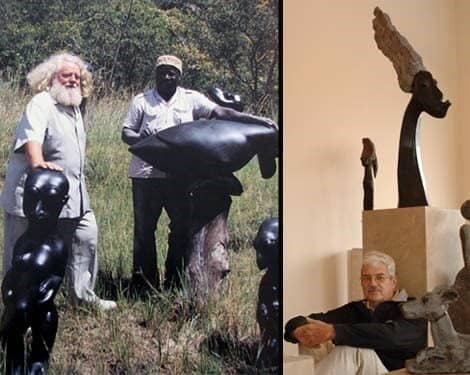The History
For the past 50 years, Zimbabwe Stone Sculpture has been a contemporary art phenomenon that has played a significant role in the development of art from Africa. This explosion of cultural expression had early influence from Joram Mariga and his Nyanga Group in 1957 but the main thrust came from the new National Gallery under its first Director, Frank McEwan in 1957/1958.
Other important communities such as Tengenenge, in Guruve, and Chapungu Sculpture Park became involved in the late sixties and still support and promote artists to this day. The early artists, principally associated with the National Gallery Workshop, derived their inspiration mainly from their own culture and beliefs in which the natural world plays a significant role. Sadly, many of these artists are no longer with us.
The past 26 years has seen the impact of the second and third generation sculptors. These dynamic talents are exploring new dimensions, often using larger and harder stones, portraying topical and social issues, and incorporating more abstract forms.
Since 1970, Chapungu has been foremost in the promotion of this art form and has run almost all the major exhibitions of importance. In doing this, it has established the reputations and careers of many artists and brought much critical acclaim to the art form.


The Name Chapungu
Chapungu (Cha-POON-goo) is the name given to the monumental stone sculptures produced by the present-day Shona people in Zimbabwe, Africa. Chapungu is defined as the “Great Spirit Bird” or Eagle of Zimbabwe, which protects and warms of danger, often bringing an important message. Stone sculpting is a means of expression by Shona people, emerging on the art scene since the early 1960’s. As popularity grew, access to a greater market allowed the artists to experiment with a larger variety of stone, especially harder stones such as serpentine, opal and springstone. These harder stones have allowed artists to create more detail in their sculptures than softer stones. These beautifully designed sculptures are all hand-carved.
The Park
Spanning 26 acres and featuring more than 80 stone sculptures, this one-of-a-kind public and permanent outdoor exhibit portrays a traditional African perspective of family. Eight universal themes include: Nature and the Environment, Village Life, the Role of Women, the Elders, the Spirit World, Customs and Legend, and the Family and the Children.
The sculptures are handmade of stone from Zimbabwe and are direct, powerful and deeply expressive. They elicit an experience that reminds the viewer of those matters so important in traditional African families and to all humankind.
“Chapungu” is the African name for the Bateleur eagle, an African eagle possessed of great presence and exceptional power of flight. The Zimbabwe people revere the bird as a spirit messenger, a protecting spirit and a good omen.
As a refuge of calm and contemplation, Chapungu Sculpture Park at Centerra is the largest outdoor art center in the United States devoted to the stone sculptors of Zimbabwe. Aligning with the company’s purpose to create great places for people, McWhinney donated the land for the Chapungu Sculpture Park in 2007. It has been through the vision, determination and commitment of McWhinney and Chapungu’s directors and staff that the park has taken shape and become a reality. Establishing Chapungu Sculpture Park in Centerra further solidifies Loveland’s legacy of being named among the top ‘great art destinations’ in the United States by U.S. Art Magazine.
It is hoped that this exhibition will remind viewers of the depth and wisdom of many traditional African cultures and emphasize the validity and expressive power of these great African stone sculptures.
Geared to connect visitors to a natural amenity that evokes emotion and ties back to the legacy of Loveland’s sculpture culture and community, our partners welcome you to Chapungu and invite you to experience a world larger than your own.

